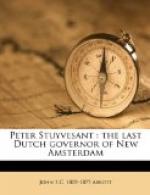“are enforcing their unlimited patent according to their own interpretation, and the total loss of New Netherland is threatened. The English, to cloak their plans, now object that there is no proof, no legal commission or patent, from their High Mightinesses, to substantiate and justify our rights and claims to the property of this province, and insinuate that through the backwardness of their High Mightinesses to grant such a patent, you apparently intended to place the people here on slippery ice, giving them lands to which your honors had no right whatever.”
Governor Stuyvesant sent with this remonstrance a private letter to the home government, in which he urged that the boundary question should be settled by the national authorities of the two countries. “It is important,” he said,
“that the States-General should send letters to the English villages on Long Island, commanding them to return to their allegiance. And that the objections of Connecticut may be met, the original charter of the West India Company should be solemnly confirmed by a public act of their High Mightinesses, under their great seal, which an Englishman commonly dotes upon like an idol.”
Scarcely were these documents dispatched when new and still more alarming outbreaks occurred. Two Englishmen, Anthony Waters of Hempstead, and John Coe of Middlebury, with an armed force of nearly one hundred men, visited most of what were called the English villages, convoked the people, told them that their country belonged to the king of England, and that they must no longer pay taxes to the Dutch. They removed the magistrates and appointed their own partisans in their stead. They then visited the Dutch towns and threatened them with the severest vengeance if they did not renounce all allegiance to the Dutch authorities, and take the oath of fealty to the king of England.
Only four weeks after this, another party of twenty Englishmen from Gravesend, Flushing and Jamaica, secretly entered Raritan river, in a sloop, and sailing up the river several miles, assembled the chiefs of some of the neighboring tribes, and endeavored to purchase of them a large extent of territory in that region. They knew perfectly well not only that they were within the bounds which had been the undisputed possession of New Netherland for nearly half a century, but that the Dutch had also purchased of the Indians all their title to these lands.
Stuyvesant, being informed of this procedure, promptly sent Ensign Crygier, with an armed force, in a swift sailing yacht, to find the English and thwart their measures. At the same time he sent Hans, a friendly Indian, in whom he could repose confidence, to warn the sachems against selling over again, lands to which they no longer had any title. The Dutch party reached the spot where the Englishmen and the Indians were in council, just in time to stop the sale. The Indians were shrewd enough to know that all they could give was a “quit claim” title, and they were very willing to give that in view of the rich remuneration which was offered them.




